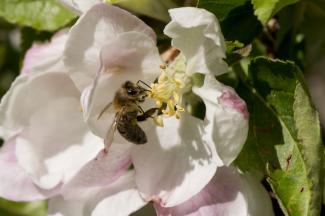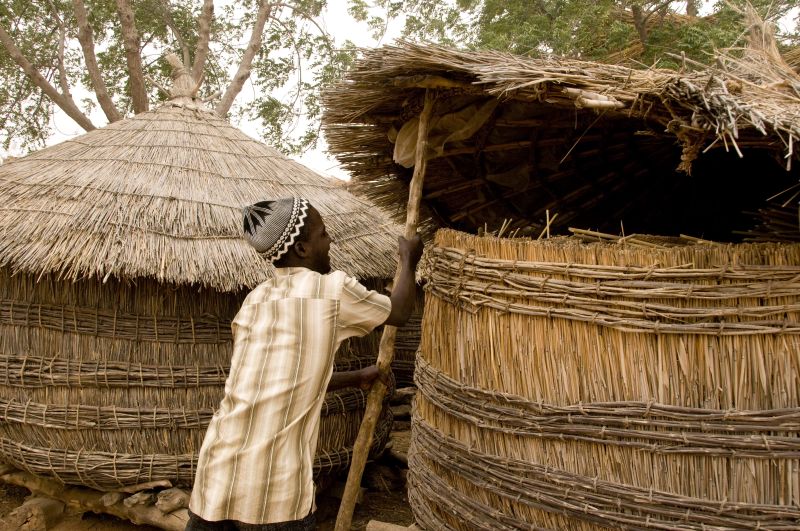Global environment
Fundamental questions of survival

The vast majority of nations have ratified the UN Convention on Biological Diversity (CBD). It was agreed at the Earth Summit in Rio de Janeiro in 1992 and took force in late 1993, when 60 nations had ratified the treaty. The CBD is an acknowledgement of the intrinsic value of biological diversity on earth as well as a recognition of its importance for humanity. The Convention’s goals are the protection, preservation and restoration of biodiversity, which is defined as the “variety of life on earth and the natural patterns it forms”. This variety includes plants, animals and micro-organisms. Apart from the diversity between species, the genetic diversity within species is important.
Planet earth’s ability to sustain life depends on biodiversity – and not only, because the dwindling of species and the climate crisis are interrelated (see box next page). Unchecked, the erosion of biodiversity will doom humanity to disaster. Hunger would spread further, and eradicating it as envisioned in the UN’s second Sustainable Development Goal (SDG 2) would become even more difficult.
According to estimates of the UN Food and Agriculture Organization (FAO), approximately 9.9 % of the world population faced hunger in 2020, while 12 % faced severe food insecurity. Additional serious challenges are under- and malnutrition. Nutrient deficiencies undermine a person’s health. The impacts include stunting (low height for age), which currently affects about 22 % of the world’s children under five, and wasting (low weight for height), which affects almost seven percent. The Covid-19 pandemic has exacerbated food insecurity, with more people suffering hunger in 2020 than in 2019.
In view of these facts, it is important to understand the links between biodiversity and food security. Indeed, agriculture, forestry and fisheries depend on biodiversity in many different ways. The dwindling of species and the erosion of genetic variety within species has a negative impact on productivity and can make established agricultural practices unviable.
Ecosystem services
Biodiversity is the basis of ecosystem services, which the CBD defines as “benefits humans derive from ecosystems”. The most obvious of these services is the direct provision of food. In developing countries, the diets of many people include wild-grown food (such as fruits, vegetables, tubers, fish and hunted animals). Prosperous nations consume wild food resources too. Most of the world’s aquatic food consumption is not based on aquaculture but on the harvesting of natural resources.
Not only the wild growth of food depends on ecosystem services however. The cultivation of crops does so too. Relevant issues include pollination, soil health and the resilience to shocks. Ecosystems, moreover, have an impact on micro-climates, water supply and air quality.
Bees are the most important pollinators. The evidence shows that pollination by bees improves the more other insect populations are also in abundance. Global declines in bee and other insect populations adversely affect crop yields, according to recent studies. As a matter of fact, various other insects are pollinators too, and so are some bats and birds.
Studies prepared on behalf of the UN conclude that land insect populations have declined on average by one to two percent annually in the past 40 years. At the same time, yields of crops have been 13 % lower for animal-dependent crops than for others. According to a publication for the UN Food Systems Summit, 75 % of crop types, including fruits, vegetables and various cash crops, are pollinated by animals.
Biodiversity in soils enhances a field’s productivity. Healthy soils support higher yields. Soil quality depends on microorganisms, insects and small animals, which all contribute to the decomposition of matter into essential nutrients, but also help to retain soil nutrients. Microorganisms play a key role in nitrogen and other nutrient cycles. Bacteria fix atmospheric nitrogen and break down proteins in dead organic matter, with compounds boosting plant growth. Earthworms in soils have an impact on physical properties. Various organisms are in symbiotic relationships with one another.
Agriculture’s resilience to shocks, moreover, depends on the biodiversity of its plants and animals. The greater the diversity is, the less damage extreme weather or new diseases are likely to cause.
If people’s food supply depends on a single crop variety, disaster can strike fast. That happened in Ireland when the potato blight disease caused famine in 1840s. Moreover, genetic diversity within cultivated species helps farming systems withstand stress caused by drought, heat or excessive rain. Accordingly, the FAO praises farmers in Ethiopia and in the Sahel region for systematically growing several different varieties. This approach helps to prevent devastating crop failures because shocks do not affect all cultivars in the same way. Indeed, environmentalists have been arguing for decades that traditional land races are very important in this context (see interview with Melaku Worede in D+C/E+Z 2012/03, p. 102).
It is sometimes argued that high-tech agriculture with hybrid seed, innovative pesticides and ample use of fertilisers are what will save humanity. This is a fallacy. Monocultures are particularly vulnerable, pesticides are poisonous and fertilisers result from energy-intensive production processes. Food-production systems of this kind are actually major drivers of biodiversity loss, reducing the gene pools that facilitate the breeding of varieties resilient against various kinds of shocks.
Scientists sounding the alarm
Scientists’ understanding of how agricultural productivity is related to biodiversity keeps improving. The trends they detect are worrisome. The Intergovernmental Platform on Biodiversity and Ecosystem Services (IPBES) reckoned in 2019 around a million species of animals and plants were threatened with extinction. Supposedly “modern” agricultural practices are part of the problem. The IPBES is based in Bonn and serves at the equivalent of the Intergovernmental Panel on Climate Change (IPCC). Both bodies regularly publish reports. The FAO too has released various reports relating to biodiversity and ecosystem services.
Humankind has too long systematically failed to fully grasp the economic relevance of ecosystem services. Since they are not paid for, economists’ models have generally taken them for granted. This must change, as was stated compellingly in a flagship report which was prepared on behalf of the British government. Partha Dasgupta of Cambridge University was the lead author (see Katja Dombrowski in magazine section of D+C/E+Z e-Paper 2021/04).
Food researchers emphasise the need for efforts at local, national and global levels to protect and preserve biodiversity in all its forms. Our common future depends on fast and determined action to stem the dangerous erosion of biodiversity.
Sundus Saleemi is senior researcher at the Center for Development Research (ZEF) of Bonn University. She recently worked with the independent Scientific Group that supported the UN Food Systems Summit in September 2021.
sundus.saleemi@gmail.com
Korrektion, 25 October: Due to an editorial mistake, the orginal version of this blogpost stated that ending hunger was the 1st SDG. It ias actually the 2nd.













